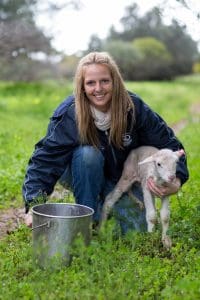
Jessica Crettenden has been researching the effect of grazing on wheat performance at the Minnipa Agricultural Centre.
MERINO sheep in a nine-year South Australian cropping trial have been shown to improve productivity and profitability, particularly in a higher input system, with no apparent negative effect on soil or system health.
The trial at Minnipa, on South Australia’s Eyre Peninsula from 2008 to 2016, found incorporating livestock into the rotation increased nitrogen (N) cycling and water use efficiency, reduced weed and pest populations and had no negative effects on cereal performance, while value adding to stubble and pastures through grazing.
The high input grazed farming system had a gross margin of over $100/ha/year more than lower input and ungrazed treatments over the nine-year trial period. Grazed treatments appeared to have lower snail and mice populations, increased ground cover outside of the growing season and reduced summer weed height and density.
SARDI researcher Jessica Crettenden at the Minnipa Agricultural Centre, ran the broadacre trial with a wheat-medic rotation to test whether productivity could be improved under a higher input system (eg. higher fertiliser and seeding rates, establishment of improved pasture) compared to a lower input and more traditional system (district practice seed and fertiliser inputs, volunteer pasture), and what effect this had on soil fertility.
The trial involved dividing a 14ha red sandy loam portion of a paddock on Minnipa Agricultural Centre into four 3.5ha sections. Each section represented a system treatment: low input – grazed, low input – ungrazed, high input – grazed and high input – ungrazed. The pasture and grazing treatments were not imposed until 2010.
Grazed high input system offset pasture improvement costs
A basic economic analysis of the study showed that over nine years, grazing contributed $328/ha to the low input treatment and $725/ha to the high input treatment. Ms Crettenden said $274 and $651 of this was attributed to grazing medic in the pasture phases, with the remainder attributed to grazing the wheat stubbles over summer/autumn in the low and high input grazed systems respectively.
“The cost of improving pastures in the high input systems (seed and fertiliser application in 2010, and fertiliser application in 2015) was $99/ha in total.
“However the grazed high input system was able to offset these costs through the extra livestock production value, and achieved a total profit of $524/ha compared with the ungrazed high input system with a $127/ha loss for the pasture phase years,” she said.
“The low input system had minimal costs in the pasture phase years (only herbicide application) — the ungrazed low input system made a $66/ha loss in total, while the low input grazed system off-set these costs by grazing livestock, making a total profit of $208/ha.”
Ms Crettenden said the higher input system produced 1.25tDM/ha more medic biomass overall in the pasture phase of the rotation (2010, 2012 and 2015) and grazing reduced total biomass by 0.25tDM/ha on average.
“The grazed systems carried a total of 2303 and 5232 DSE grazing days in the low input and high input systems respectively during the three years of medic pasture and grazing wheat stubbles over the summer/autumn period.
“The higher input systems had 0.5t/ha greater wheat grain yield than the lower input systems and the grazed systems had 0.1t/ha more grain yield on average,’ she said.
“Total mineral N was similar for high and low input systems; however, the grazed systems had considerably more soil N on average (17 and 13kgN/ha greater in the low and high input treatments respectively).”
There was an average of 11mg/kg more extractable phosphorous in the low input system, compared to the high input treatments. Soil organic carbon remained steady throughout the lifetime of the trial, with similar results across all treatments.
Results pertinent to other cropping areas
Ms Crettenden said soil compaction was measured one year, with no differences between treatments, and any supposed compaction had no negative impact on productivity.
She believes the findings from this trial are pertinent to cropping in other low rainfall mixed farming areas.
“Other enterprise types, soil types and rainfall regions may vary, but the concept of sheep being beneficial to the whole farm system would be a common finding I think over many cropping areas across Australia.”
Ms Crettenden also believes there would be great value in repeating a similar trial in other areas of Australia.
“Unfortunately there is not much long-term trials undertaken in mixed farming areas so this is something that would be quite beneficial to occur.”
Lower sowing rates and fertiliser inputs in the low input system meant that total costs for the cropping operations for the six wheat production years (2008, 2009, 2011, 2013, 2014 and 2016) were only $2451/ha, compared with the high input systems total costs of $2845/ha. The high input systems managed to compensate these costs through increased yield with a total $5719/ha profit compared to the low input system with $4647/ha profit in total over the six years.
Over the nine years, taking into account both the cropping and livestock systems, the average gross margin of each treatment was $295, $244, $395 and $293 in the low input (grazed), low input (ungrazed), high input (grazed) and high input (ungrazed) systems respectively.
“This meant that running sheep added a $51/ha profit per annum to the conventional (low) input, ungrazed system, while adding higher inputs earnt an extra $49/ha.
“Including both sheep and higher inputs to the conventional system earnt an extra $155/ha,” Ms Crettenden said.
The nine-year period of this study began with a severe drought in 2008, followed by six years of average to above average rainfall seasons (2009-2011 and 2014-2016) and the two seasons in 2012 and 2013 slightly below average growing season rainfall.
Click here to review Table 1 – the trial paddock treatments.
Click here to review Table 2 – production and soil measurement averages.
Click here to review Table 3 – grass margin ($/ha) for different input treatments.
Source: GRDC.

HAVE YOUR SAY